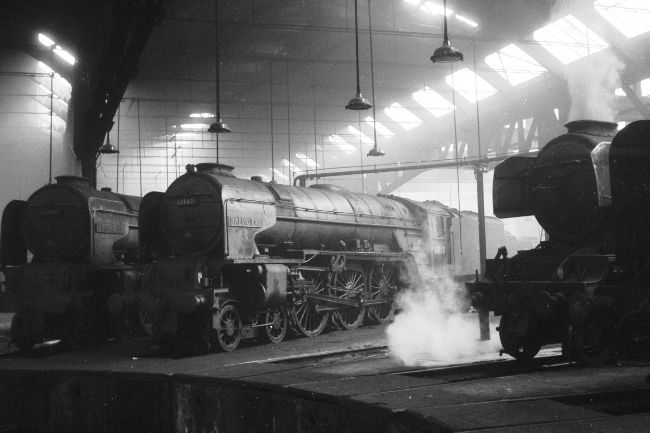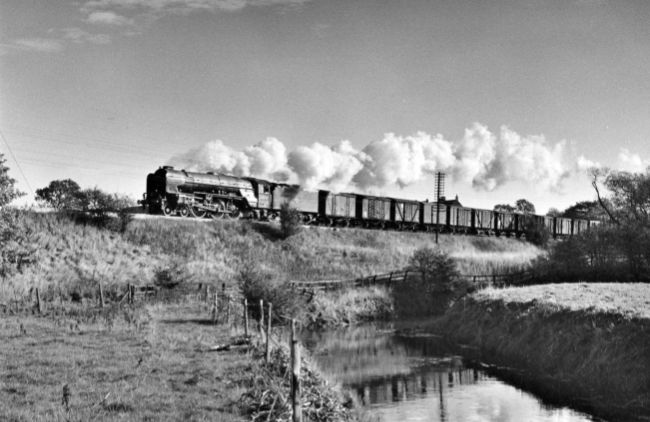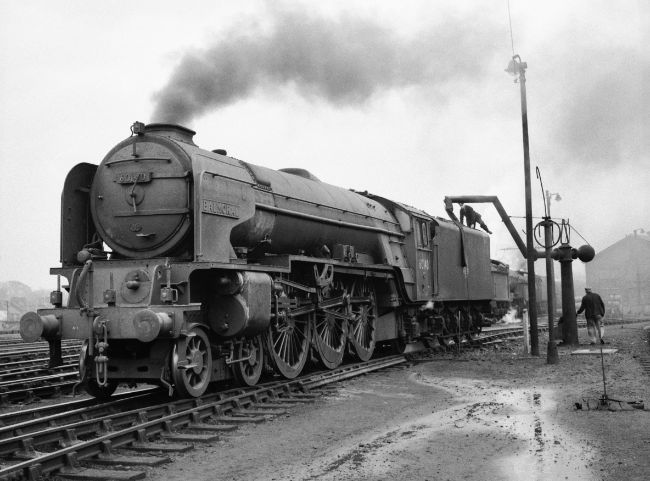Darlington Works No. 2059, equipped with boiler No. 3931 and tender 760, was completed in December 1948, one of five A1s from Darlington and three from Doncaster and that month. This was about a third of the way through the class building programme. Livery was LNER apple green with black and white lining and old gold for numerals and letters. On the tender was ‘BRITISH RAILWAYS’. Allocation was to York where it was one of a dozen A1s there. In time No. 60140 would become one of the three A1s known to have reached 100 mph.
It entered service from York (North – YK) on 24th December and was noted later at Darlington. The first recorded run for No. 60140 was the 14:12hrs Darlington-Leeds on 12th February 1949. It departed King’s Cross with the 10:05hrs bound for Glasgow on 1st July. In October 1949 it was transferred along with Nos. 60141 and 60149 to King’s Cross shed (KX) where they joined nine already there. Clearly it ran to Leeds as it was seen on Copley Hill shed on 19th February 1950.
A return to York (now 50A) with No. 60146 came in June 1950 to make a quartet of A1s there. Naming and repainting were done in July following a general overhaul at Doncaster and its appearance in BR blue with black and white lining was after the halfway stage of repainting the A1s with 30 already in this livery as No. 60140 and three others were repainted. Its naming was no less than one of seven that July to join the nine previously named examples. Opinions are divided on its name Balmoral. Like several other A1s named after residences this is the Royal residence in Deeside, it was also the name of a nineteenth century Clyde steamer. There were many sightings between September 1950 and October 1951 of a regular turn of the Leeds– Newcastle train arriving at Stockton at 13:38hrs. Usually the load was five bogie coaches, sometimes with three four-wheel vehicles added while a few times it had six or seven coaches. In November 1951 No. 60140 along with two others was repainted into BR green with orange and black lining following another ‘General’ at ‘The Plant’ which included replacing the boiler with No. 29819. This livery change was quite early on in the class with just ten done so far. It did work further afield, noted arriving at King’s Cross with an up passenger at 13:03hrs on 16th June 1952, leaving West Hartlepool on the Durham coast line at 15:30hrs on 17th March 1955 and bringing York–Edinburgh trains into Newcastle. During 1953 The 19:00hrs Edinburgh (Waverley) to Glasgow (Queen Street) Sundays only train was worked by number of York 50A locos, including No. 60140 three times. During this period it visited Doncaster for general overhauls during November 1953 (boiler No. 29822) and November 1955 (boiler No. 29813 fitted). Its first recorded named train was leaving King’s Cross on 29th November 1956 with the up ‘Flying Scotsman’.
The locomotive spent Christmas 1957 at Doncaster undergoing a further heavy general repair which included equipping the locomotive with boiler No. 29802 leaving with the later BR crest in January 1958. Balmoral left King’s Cross with the Aberdeen-bound fish empties on 10th February 1958. Notable trains for No. 60140 were the up ‘Queen of Scots’ from Newcastle on 21st August 1958 and the down morning ‘Talisman’ from King’s Cross on 7th July 1961. The locomotive again returned to Doncaster over the festive period in 1959 for an overhaul which included a boiler change (No. 29808). Balmoral took over from a failed Type 4 diesel with nine coaches at York in November 1961. Its driver was Dick Turner who did not like to be late if he could avoid it. It left over 26 minutes late but had regained six minutes in the first six miles, further cutting the deficit to 14 minutes at Grantham, 11 at Peterborough and 7¼ at Hatfield. It was notable for racing uphill at over 90 mph, reaching 100.5 mph at Essendine then over 90mph downhill. Arrival at King’s Cross was just over two minutes late. It had covered 188.2 miles in 158¼ minutes. This led to Cecil J. Allen commenting that this confirmed that the A1s were as capable of 100 mph as the A3s and A4s.

Nos. 60140 and 60146 Peregrine in York roundhouse, 1st January 1964 – John Arnott-Brown
As with other A1s the work in the early 1960s was a mixture of goods, parcels and passenger trains. Goods included an up train at Newcastle on 3rd February 1962, the up BP tanks at Newcastle at 13:15hrs on 19th December and a goods into London on 7th February 1963. Balmoral visited Doncaster one last time during May and June 1962 for a general overhaul which included the fitting and re-fitting of boiler Nos. 9658 and 29806 (history does not relate why), eventually leaving carrying boiler No. 29806. Parcels trains were usually the 3G34 York-Newcastle ones, often with a return run that evening with the up seed potatoes. An up parcels was worked into London on 31st December 1963. Passenger runs tended to be between Newcastle and King’s Cross including some additional trains into the Tyneside city. ‘Namers’ were the up ‘Tees Tyne Pullman’ of 8th November 1962 and the down ‘Scarborough Flyer’ of 29th June 1963. York A1s were rarely seen on Leeds Holbeck shed but Balmoral was noted there on 15th September 1960. Scarborough was also reached with an ex-King’s Cross train on 30th September, the locomotive returning light engine to York to be turned. There are many records of No. 60140 being serviced on Gateshead shed in 1964. That for 26th May shows it then working the 8S27 Tyne Yard-Millerhill while on the 30th it was back into Scotland taking forward the 1F75 King’s Cross-Edinburgh from Newcastle. Its last recorded runs were the 2G85 Newcastle-Berwick stopping train on 20th June and bringing a King’s Cross-Newcastle train to its destination on 23rd December.

A distant view of No. 6014o at Brafferton, March 1964 - Chris Nettleton

An undated view of No. 60140 at York shed – Bill Reed
Withdrawal came on 11th January 1965, the 26th to go. No. 60140 had six boilers during its service of 16 years 1 month, all of them to diagram 118. That is nearly a year more than the class average. It was sold for scrap to A. Draper of Hull in March 1965, being seen on Hull Dairycoates shed on 2nd April.
This history was compiled by Phil Champion based on the RCTS book “Locomotives of the LNER Part 2A”, a database supplied by Tommy Knox of the Gresley Society, “The Power of the A1s” by Gavin Morrison and various published photographs. Revised and updated by Graham Langer, July 2020.